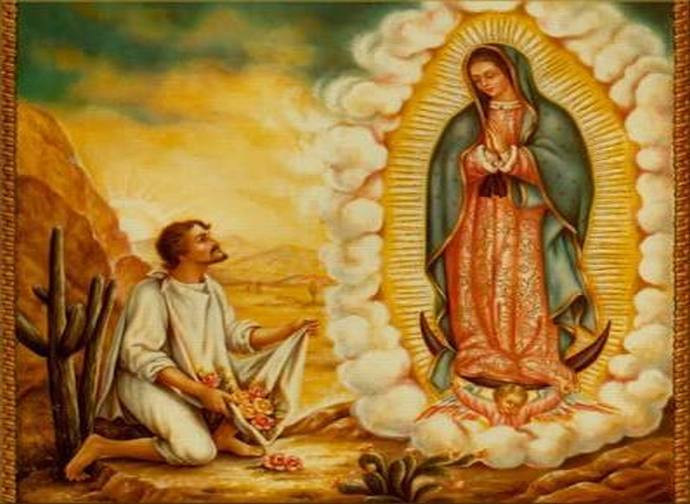Saint Juan Diego Cuauhtlatoatzin
On the morning of Saturday December 9, 1531, the Blessed Virgin appeared to the peasant Juan Diego Cuauhtlatoatzin (1474-1548) on the hill of Tepeyac, near Mexico City, presenting herself as “the perfect ever-Virgin Mary, Mother of the one true God.”

On the morning of Saturday December 9, 1531, the Blessed Virgin appeared to the peasant Juan Diego Cuauhtlatoatzin (1474-1548) on the hill of Tepeyac, near Mexico City, presenting herself as “the perfect ever-Virgin Mary, Mother of the one true God.” Thus began the extraordinary story of Our Lady of Guadalupe. The visionary was a humble Aztec who seven years earlier had received baptism from the Franciscans, among the first missionaries in Mexican lands. It was in fact in the phase immediately following the discovery of America (the Aztec empire was conquered in 1521 by the Spaniards led by Hernán Cortés). In receiving the sacrament, the then fifty-year-old Cuauhtlatoatzin - which in Nahuatl means “the eagle who speaks” - took the Christian name of Juan Diego; together with him his wife was baptized, with the name of Maria Lucia. The woman died four years later and the widower Juan Diego reacted to the loss by orienting his life even more to God.
It was in this context that the apparition of December 9 took place, the first of a cycle of four that ended on the 12th. As reported by an old text in the Aztec language (the Nican Mopohua) attributed to the native Antonio Valeriano (c. 1522-1605 ), Juan Diego “saw a young Lady who called him gently” and ordered him to go to the bishop to have a chapel built there, “because I am your merciful Mother and of all those who inhabit this land. Here I will listen to your weeping and heal your many sufferings.” The visionary presented himself to the bishop, the Spanish Juan de Zumarraga, but was not believed. In a second vision Juan Diego, dispirited, suggested that the duty be entrusted to somoene else, because “I am a poor Indian,” but the Virgin told him that he must be the one to carry out the mission and asked him to return to the bishop. Zumarraga, after questioning him about the circumstances of the apparition, asked him for a sign. The Indian then obtained the promise from the Virgin, but an unexpected development complicated matters.
On the decisive day, Juan Diego hastily set out on another road, thinking of avoiding the apparition, because he was looking for a priest who would give the sacraments to a dying uncle. The Virgin appeared to him anyway, reassured him about her uncle's health and ordered him to climb to the top of Tepeyac, where “you will find a large quantity of flowers. Gather them and bring them here to me.” Despite the season and the place, the Indian found on the hill some splendid flowers of Castile, a kind of rose typical of the Spanish region, which he kept in his tilma, a garment used as a cloak and which for the poor consisted of a simple, rough fabric of agave fibers. “My little son, these flowers will be the sign for the bishop. Only in his presence will you open the tilma and show what you bring,” the Blessed Mother said to him. Juan Diego went again to Zumarraga: to show the flowers before him and seven other people, he opened the cloak on which was immediately imprinted an image of the Celestial Mother, with the face of a mestiza, to the astonishment of the bishop who knelt, moved with emotion, along with all those present.
Shortly afterwards the chapel in honor of the Virgin was erected on Tepeyac and the bishop had a small house built next to it, where Juan Diego spent the last 17 years of his earthly life offering prayers and penances and dying with a reputation of holiness, attested to by the uninterrupted devotion surrounding him. Those apparitions and the exceptional nature of the image imprinted on the tilma, preserved over the centuries and subjected to various scientific analyzes that have confirmed its acheiropoietic nature (i.e. not made with human hands), marked the beginning of an extraordinarily vital evangelization. Today millions of pilgrims go to the present-day Basilica of Our Lady of Guadalupe, whom the faithful call Virgen morenita.
Juan Diego was canonized in 2002 by John Paul II (thanks to the recognition of the miraculous healing, in 1990, of the young Mexican Juan José Barragan Silva after the prayers of his mother, who had asked for the intercession of the then-Blessed), who recalled in his homily how the indigenous saint “facilitated the fruitful meeting of two worlds and became the catalyst for the new Mexican identity, closely united to Our Lady of Guadalupe, whose mestizo face expresses her spiritual motherhood which embraces all Mexicans.”




